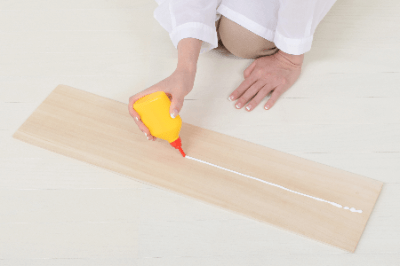What Is Glue?

Glue refers to all adhesives produced by Konishi Corporation and is registered as a trademark.
The most well-known type is for woodworking, which is mainly composed of vinyl acetate resin emulsion. Other types of adhesives are used according to the type of material to be bonded.
Compared to other bonding and joining methods, it is quicker to work with, and superior in terms of the types of materials it can handle and resistance to torsion.
Uses of Glue
Glue is used for adhesion in a wide range of applications, including household, construction, and industrial uses.
The most commonly used glue is “wood glue,” which is suitable for bonding wood, paper, cloth, etc. However, other products are used for bonding metals and plastics.
Some materials, such as PE and PP, are not suitable for bonding as they are, so the surface may be treated with heat or acid in advance. Acrylics may be bonded by melting the surface with acrylic resin.
Principle of Glue
In the case of a typical wood glue, vinyl acetate resin, the adhesive component, exists as a colloid in water as a solvent. When the water evaporates, the vinyl acetate hardens and the adhesive action is achieved. This type of adhesive is called a dry-curing adhesive and can be applied to many materials, but it is somewhat inferior in water resistance and heat resistance. It is recommended to bond to smooth surfaces.
Products that are used by mixing two types of ingredients called the main agent and curing agent are called chemically reactive adhesives. Silicone rubber-based and epoxy resin-based products fall into this category. These products have strong adhesive strength and excellent resistance to water and heat, but they are somewhat expensive because they use two types of components, and they require a long time to bond at low temperatures.
Adhesives exhibit three types of interaction on the surface to be bonded. The three types of interactions include mechanical bonding, in which the adhesive penetrates into uneven surfaces and connects objects like a nail; intermolecular interactions between the glue and the surface to be adhered (physical bonding); and structural changes between the glue and the surface to be adhered (chemical bonding).